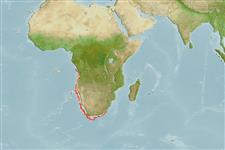Lớp phụ Cá sụn (cá mập và cá đuối) (sharks and rays) >
Rajiformes (Skates and rays) >
Arhynchobatidae (Softnose skates)
Etymology: Bathyraja: Greek, bathys = deep + Latin, raja, -ae = a ray (Raja sp) (Ref. 45335).
Eponymy: Dr Sir Andrew Smith (1797–1872) was a Scotsman who joined the Army Medical Service (1819) after graduating from Edinburgh University. [...] (Ref. 128868), visit book page.
More on authors: Müller & Henle.
Environment: milieu / climate zone / Mức độ sâu / distribution range
Sinh thái học
Biển Tầng đáy biển sâu; Mức độ sâu 440 - 1020 m (Ref. 5578). Deep-water; - 40°S
Southeast Atlantic: off central Namibia to Agulhas Bank, South Africa.
Bộ gần gũi / Khối lượng (Trọng lượng) / Age
Chín muồi sinh dục: Lm ? range ? - ? cm
Max length : 120 cm TL con đực/không giới tính; (Ref. 5578)
Short description
Khóa để định loại | Hình thái học | Sinh trắc học
A large softnose skate with a broadly triangular, bluntly pointed snout and an angular pectoral disc; tail shorter than body and with a single row of large thorns; upper disc of young with thorns but these are lost with growth (Ref. 5578). Dorsal surface greyish and may have white spots, ventral surface white with dark grey blotches around gill slits, vent and along ventral surface of tail (Ref. 5578). Tail with no color bands (Ref. 5578).
Body shape (shape guide): other.
Found on the upper continental slope (Ref. 27121). A bottom-predator that feeds on bony fishes including hake, jacopever, barracudina and dragonet; also squid, octopus, crabs and prawns (Ref. 5578). Oviparous (Ref. 50449). Eggs have horn-like projections on the shell (Ref. 205). Sometimes caught by hake trawlers (Ref. 5578).
Life cycle and mating behavior
Chín muồi sinh dục | Sự tái sinh sản | Đẻ trứng | Các trứng | Sự sinh sản | Ấu trùng
Oviparous, paired eggs are laid. Embryos feed solely on yolk (Ref. 50449). Eggs have horn-like projections on the shell (Ref. 205).
McEachran, J.D. and K.A. Dunn, 1998. Phylogenetic analysis of skates, a morphologically conservative clade of elasmobranchs (Chondrichthyes: Rajidae). Copeia 1998(2):271-290. (Ref. 27314)
IUCN Red List Status (Ref. 130435: Version 2025-1)
Threat to humans
Harmless
Human uses
Các nghề cá: bycatch
Các công cụ
Special reports
Download XML
Các nguồn internet
Estimates based on models
Preferred temperature (Tài liệu tham khảo
123201): 4.6 - 11.8, mean 5.4 °C (based on 13 cells).
Phylogenetic diversity index (Tài liệu tham khảo
82804): PD
50 = 0.5000 [Uniqueness, from 0.5 = low to 2.0 = high].
Bayesian length-weight: a=0.00550 (0.00291 - 0.01038), b=3.13 (2.97 - 3.29), in cm total length, based on LWR estimates for this Genus-body shape (Ref.
93245).
Mức dinh dưỡng (Tài liệu tham khảo
69278): 4.3 ±0.67 se; based on food items.
Thích nghi nhanh (Tài liệu tham khảo
120179): thấp, thời gian nhân đôi của chủng quần tối thiểu là 4.5 - 14 năm (Fec assumed to be <100).
Fishing Vulnerability (Ref.
59153): High to very high vulnerability (72 of 100).
🛈
